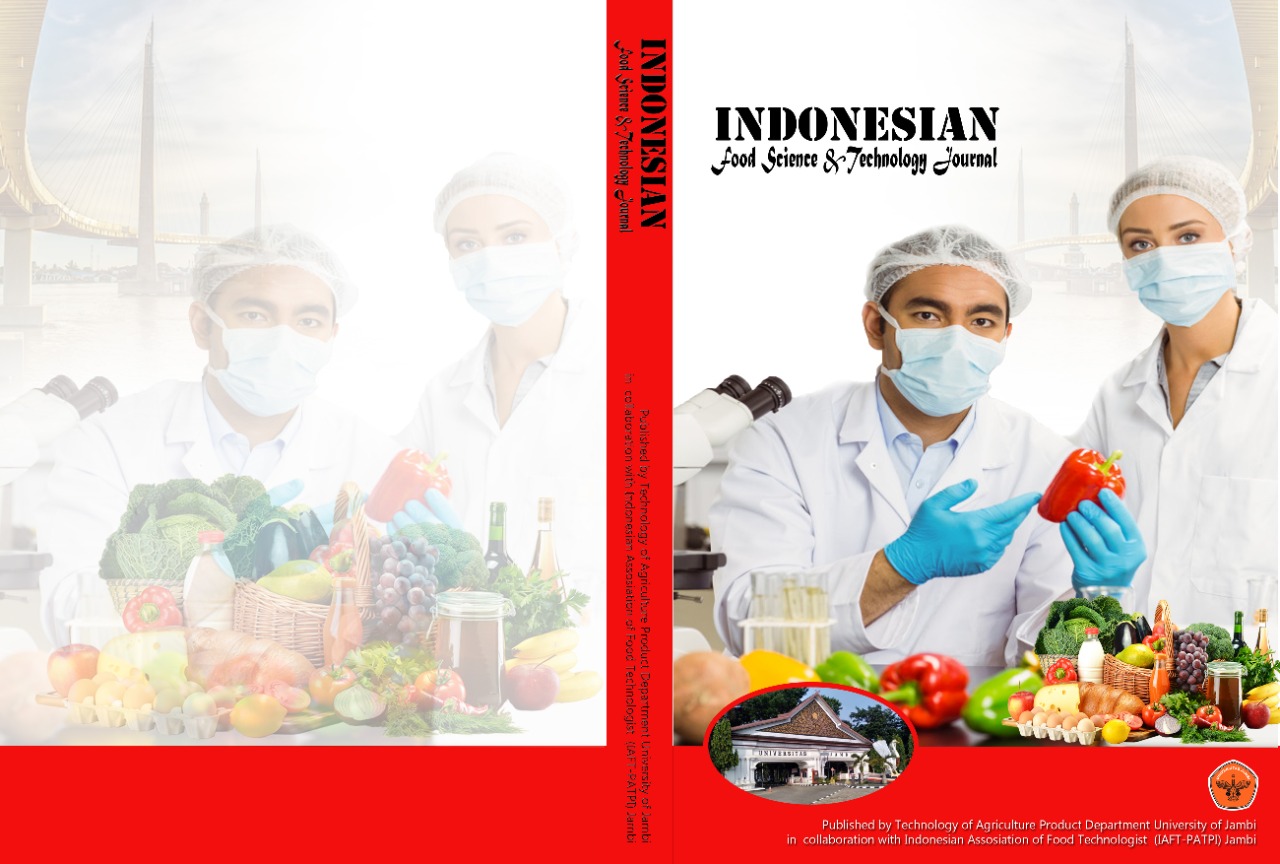Development of Functional Cookie from Kenaf (Hibiscus Cannabinus L.) Seed Meal
DOI:
https://doi.org/10.22437/ifstj.v8i1.32872Keywords:
Functional cookies, kenaf seed meal flour, proximate analysis, sensory evaluationAbstract
Kenaf seed (Hibiscus cannabinus L.) is one of the potential and excellent food ingredients of kenaf processing by-products. This study aims to develop functional cookies by incorporating 0% (control), 15%, 20%, 25%, and 30% of kenaf seed meal flour (KSMF). The physicochemical quality of kenaf seed meal cookies (KSMC) revealed that KSMC had higher ash, protein and fat content but lower moisture and carbohydrate content than the control. In terms of texture and colour, the hardness and colour values of the KSMC increased and decreased with increasing levels of KSMF, respectively. Sensory scores on acceptability using hedonic test depicted that KSMF addition had no effect on the overall acceptability score of all the cookies. The finding of this study suggested that 30% of KSMF is suitable for use in the development of functional cookies with improved nutritional quality while maintaining the sensory acceptability of the cookies.
Downloads
References
I. Kamal, M. Z. Thirmizir, G. Beyer, M. J. Saad, N. A. A. Rashid, and Y. A. Kadir, “Kenaf For Biocomposite: An Overview,” Journal of Science and Technology, vol. 6, no. 2, pp. 41–66, 2014, [Online]. Available: http://penerbit.uthm.edu.my/ojs/index.php/JST/article/view/796.
FAO, “Jute , Kenaf , Sisal, Abaca, Coir and Allied Fibres Statistical Bulletin,” pp. 6–7, 2018.
E. Alexopoulou, Y. Papatheohari, D. Picco, N. Di Virgilio, and A. Monti, Kenaf: A Multi-Purpose Crop for Several Industrial Applications. 2013.
K. W. Chan, N. M. H. Khong, S. Iqbal, S. M. Mansor, and M. Ismail, “Defatted kenaf seed meal (DKSM): Prospective edible flour from agricultural waste with high antioxidant activity,” LWT - Food Science and Technology, vol. 53, no. 1, pp. 308–313, Sep. 2013, doi: 10.1016/j.lwt.2013.01.003.
G. A. Nevara, S. K. S. Muhammad, N. Zawawi, N. A. Mustapha, and R. Karim, “Physicochemical and functional properties of carbohydrate–protein gum extracted from kenaf (Hibiscus cannabinus L.) seed,” International Journal of Food Science & Technology, vol. 57, no. 1, pp. 258–267, Jan. 2022, doi: 10.1111/ijfs.15421.
S. G. Ibrahim, W. Z. W. Ibadullah, N. Saari, and R. Karim, “Functional properties of protein concentrates of KB6 kenaf (Hibiscus cannabinus) seed and its milky extract,” LWT - Food Science and Technology, vol. 135, p. 110234, Jan. 2021, doi: 10.1016/j.lwt.2020.110234.
N. S. Kai, T. A. Nee, E. L. C. Ling, T. C. Ping, L. Kamariah, and N. K. Lin, “Anti-hypercholesterolemic effect of kenaf (Hibiscus cannabinus L.) seed on high-fat diet Sprague dawley rats,” Asian Pacific Journal of Tropical Medicine, vol. 8, no. 1, pp. 6–13, 2015, doi: 10.1016/S1995-7645(14)60179-6.
R. Karim, N. A. M. Noh, S. G. Ibrahim, W. Z. W. Ibadullah, N. Zawawi, and N. Saari, “Kenaf (Hibiscus cannabinus L.) Seed Extract as a New Plant-Based Milk Alternative and Its Potential Food Uses,” in Milk Substitutes, M. Ziarno, Ed. London: IntechOpen, 2020, pp. 1–13.
E. C. Omenna, D. C. Uzuegbu, and D. D. Okeleye, “Functional and Nutritional Properties of Kenaf Seed,” EC Nutrition, vol. 11, pp. 166–172, 2017, [Online]. Available: https://www.ecronicon.com/ecnu/pdf/ECNU-11-00384.pdf.
K. L. Nyam, C. P. Tan, O. M. Lai, K. Long, and Y. B. Che Man, “Physicochemical properties and bioactive compounds of selected seed oils,” Lwt, vol. 42, no. 8, pp. 1396–1403, 2009, doi: 10.1016/j.lwt.2009.03.006.
K. W. Chan et al., “Defatted Kenaf (Hibiscus cannabinus L.) seed meal and its phenolic-saponin-rich extract protect hypercholesterolemic rats against oxidative stress and systemic inflammation via transcriptional modulation of hepatic antioxidant genes,” Oxidative Medicine and Cellular Longevity, vol. 2018, 2018, doi: 10.1155/2018/6742571.
N. A. F. M. Ramlan et al., “Nutritional Composition, Techno-Functional Properties and Sensory Analysis of Pan Bread Fortified with Kenaf Seeds Dietary Fibre,” Sains Malaysiana, vol. 50, no. 11, pp. 3285–3296, 2021, doi: 10.17576/jsm-2021-5011-12.
N. Zawawi, P. Gangadharan, R. Ahma Zaini, M. G. Samsudin, R. Karim, and I. Maznah, “Nutritional values and cooking quality of defatted Kenaf seeds yellow (DKSY) noodles,” International Food Research Journal, vol. 21, no. 2, pp. 603–608, 2014, [Online]. Available: https://www.scopus.com/inward/record.uri?eid=2-s2.0-84896947576&partnerID=40&md5=066c5dda39f6a5e920fd0418509018b2.
A. A. N. Aziah, A. Y. M. Noor, and L. H. Ho, “Physicochemical and organoleptic properties of cookies incorporated with legume flour,” International Food Research Journal, vol. 19, no. 4, pp. 1539–1543, 2012.
P. I. Akubor, “Functional properties and performance of cowpea/plantain/wheat flour blends in biscuits,” Plant Foods for Human Nutrition, vol. 58, no. 3, pp. 1–8, 2003, doi: 10.1023/B:QUAL.0000041154.09382.d8.
O. A. Adekunle and A. A. Mary, “Evaluation of cookies produced from blends of wheat, cassava and cowpea flours,” International Journal of Food Studies, vol. 3, no. 2, pp. 175–185, 2014, doi: 10.7455/ijfs/3.2.2014.a4.
K.-L. Nyam, S.-Y. Leao, C.-P. Tan, and K. Long, “Functional properties of roselle (Hibiscus sabdariffa L.) seed and its application as bakery product,” Journal of Food Science and Technology, vol. 51, no. 12, pp. 3830–3837, 2014, doi: 10.1007/s13197-012-0902-x.
A. Hawa, N. Satheesh, and D. Kumela, “Nutritional and anti-nutritional evaluation of cookies prepared from okara, red teff and wheat flours,” International Food Research Journal, vol. 25, no. 5, pp. 2042–2050, 2018.
D. J. Frost, K. Adhikari, and D. S. Lewis, “Effect of barley flour on the physical and sensory characteristics of chocolate chip cookies,” Journal of Food Science and Technology, vol. 48, no. 5, pp. 569–576, 2011, doi: 10.1007/s13197-010-0179-x.
D. Portman et al., “Nutritional and functional properties of cookies made using down-graded lentil – A candidate for novel food production and crop utilization,” Cereal Chemistry, vol. 97, no. 1, pp. 95–103, 2020, doi: 10.1002/cche.10232.
L. H. Ho and N. W. binti Abdul Latif, “Nutritional composition, physical properties, and sensory evaluation of cookies prepared from wheat flour and pitaya (Hylocereus undatus) peel flour blends,” Cogent Food and Agriculture, vol. 2, no. 1, 2016, doi: 10.1080/23311932.2015.1136369.
K. M. Deamici, L. C. de Oliveira, G. S. da Rosa, E. R. Zavareze, and E. G. de Oliveira, “Development of cookies from agroindustrial by-products | Desenvolvimento de biscoitos a partir de subprodutos da agroindústria,” Revista Brasileira de Fruticultura, vol. 40, no. 2, 2018.
AOAC, “Official Methods of Analysis of AOAC INTERNATIONAL 18th Edition,” 2005.
A. A. Kulthe, S. S. Thorat, and S. B. Lande, “Evaluation of Physical and Textural Properties of Cookies Prepared from Pearl Millet Flour,” International Journal of Current Microbiology and Applied Sciences, vol. 6, no. 4, pp. 692–701, 2017.
Y. F. Cheng and R. Bhat, Functional, physicochemical and sensory properties of novel cookies produced by utilizing underutilized jering (Pithecellobium jiringa Jack.) legume flour, vol. 14. Elsevier, 2016.
H. K. W. Aslam et al., “Utilization of mango waste material (peel, kernel) to enhance dietary fiber content and antioxidant properties of biscuit,” Journal of Global Innovations in Agricultural and Social Sciences, no. July 2020, 2014, doi: 10.17957/JGIASS/2.2.533.
M. V. Ostermann-Porcel, N. Quiroga-Panelo, A. N. Rinaldoni, and M. E. Campderrós, “Incorporation of okara into gluten-free cookies with high quality and nutritional value,” Journal of Food Quality, vol. 2017, no. Ldl, 2017, doi: 10.1155/2017/4071585.
S. Kasapis and A. Bannikova, “Rheology and food microstructure,” in Advances in Food Rheology and Its Applications: Development in Food Rheology, Second Edition, LTD, 2017, pp. 27–62.
B. S. Ahmad et al., “Protein bread fortification with cumin and caraway seeds and by-product flour,” Foods, vol. 7, no. 3, 2018, doi: 10.3390/foods7030028.
N. S. Azmi, R. Bhat, and T. K. Yeoh, “Quality evaluation of novel cookies prepared by supplementing with fresh turmeric flower (Curcuma longa L.) extracts as a value added functional ingredient,” International Food Research Journal, vol. 23, no. 4, pp. 1514–1522, 2016.
R. C. Borrelli et al., “Characterization of coloured compounds obtained by enzymatic extraction of bakery products,” Food and Chemical Toxicology, vol. 41, no. 10, pp. 1367–1374, 2003, doi: 10.1016/S0278-6915(03)00140-6.
G. Ghoshal and P. Kaushik, “Development of soymeal fortified cookies to combat malnutrition,” Legume Science, vol. 2, no. 3, pp. 1–13, 2020, doi: 10.1002/leg3.43.
F. Ullah et al., “Quality evaluation of biscuits supplemented with alfalfa seed flour,” Foods, vol. 5, no. 4, pp. 1–11, 2016, doi: 10.3390/foods5040068.
S. Zydenbos and V. Humphrey-Taylor, “The biscuits, cookies and crackers,” Biscuit Baking Technology, pp. 524–528, 2003, doi: 10.1016/b978-0-323-99923-6.00015-6.
N. T. T. Nguyen, H. A. V. Le, D. A. Pham, and T. N. Y. Tran, “Evaluation of physical, nutritional and sensorial properties cookie supplied with Hibiscus sabdariffa L. seed powder (without shell),” International Food Research Journal, vol. 25, no. 3, pp. 1281–1287, 2018.
J. Jacob and K. Leelavathi, “Effect of fat-type on cookie dough and cookie quality,” Journal of Food Engineering, vol. 79, no. 1, pp. 299–305, 2007, doi: 10.1016/j.jfoodeng.2006.01.058.
E. Purlis, “Browning development in bakery products - A review,” Journal of Food Engineering, vol. 99, no. 3, pp. 239–249, 2010, doi: 10.1016/j.jfoodeng.2010.03.008.
A. Chauhan, D. C. Saxena, and S. Singh, “Physical, textural, and sensory characteristics of wheat and amaranth flour blend cookies,” Cogent Food and Agriculture, vol. 2, no. 1, 2016, doi: 10.1080/23311932.2015.1125773.
E. Martínez, R. García-Martínez, M. Álvarez-Ortí, A. Rabadán, A. Pardo-Giménez, and J. E. Pardo, “Elaboration of gluten-free cookies with defatted seed flours: Effects on technological, nutritional, and consumer aspects,” Foods, vol. 10, no. 6, pp. 1–9, 2021, doi: 10.3390/foods10061213.
Downloads
Published
How to Cite
Issue
Section
License
Copyright (c) 2024 Indonesian Food Science and Technology Journal

This work is licensed under a Creative Commons Attribution 4.0 International License.







